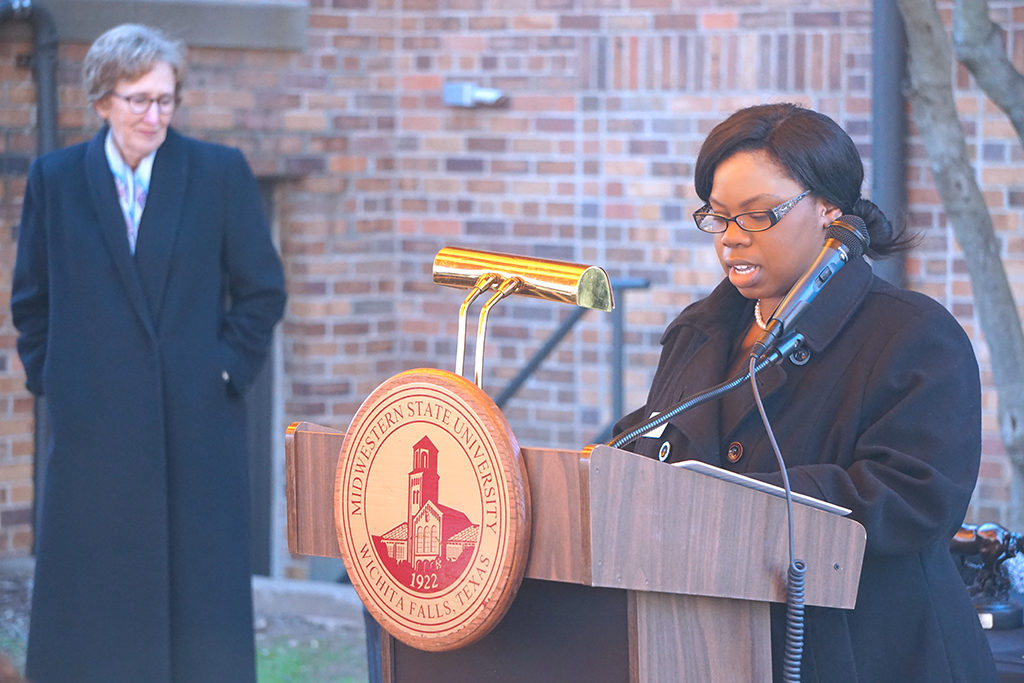
The student regent application deadline will close on Nov. 30 at 5 p.m. — but many students don’t fully understand what that position actually means.
As student regent, Shayla Owens, business administration management senior, helps the nine-member Board of Regents consider the students when making decisions that affect students throughout the campus.
Student regent is the highest appointed position of a student at Texas public institutions of higher education. The student regent represents all students, both undergraduates and graduates, for a one-year term on the Board of Regents, the university’s governing board. This position represents students in discussions of key issues in higher education. Although the student regent does not vote, he or she has the opportunity to have important input in decisions affecting the future of the university.
During the 2016-17 school year, Owens was the Student Government Association president and volunteered as a student ambassador, peer counselor and as a student representative for the Budget Oversight Committee. She previously served as president of Alpha Kappa Alpha Sorority 2014-16, and is co-founder of the Black Student Leadership Initiative.
During the summer of 2016, she participated in the Study Abroad program at Queen Mary University in London studying international issues in business.
While Owens is set to graduate in December, she plans to continue her studies on campus to pursue her master’s degree.
The board is composed of nine people, appointed by the Texas governor, for six-year terms. After the student applies for the position, Governor Greg Abbott chooses the applicant he believes is the best fit and appoints that student for a year-long term, beginning on June 1 each year.
According to Owens, the student regent position entails being the voice of the students to the Board of Regents and giving the board more detailed information about the student body as decisions are being made.
“My duties include attending quarterly board meetings and weighing in on student focus issues,” Owens said. “The goal of a student regent is to give the board more detailed information about students as decisions are being made.”
According to Keith Lamb, vice president of student affairs and enrollment management, as the student regent, the role speaks on behalf of student interests across the campus in regent meetings and activities. While the student regent is allowed to discuss issues in the regent meetings, the regent may not vote on any matter before the board. The student is not compensated for his/her duties, but can serve on committees, special commissions and task forces while holding the position.
“In Texas, every board that governs a university has one student that’s appointed by the governor,” Lamb said. “It is a none voting position and the student sits at the table with the board, they are a part of the board, they participate in the full discussion of the board, but they do not have a vote.”
In the capacity of this role students get the opportunity to attend summits, university events and meetings that warrant their attendance.
“To date, I have attended a regent forum in Austin, my first board meeting in August and been to several university events,” Owens said.
Until the Texas Legislature passed a law in 2005 that required every state university to appoint a student regent, the position of student regent was not mandatory.
According to the Texas Education Code regarding the position of student regent, before Nov. 1 of each year, the student government of each campus must gather applications for the student regent position. By Jan. 1, up to five applicants must send their applications to the student government, and the student government must then send the applications to the chancellor. The chancellor will then send at least two of the applicants to the governor no later than Feb. 1.
To apply for student regent, a student must be enrolled as an undergraduate or graduate student, be in good academic standing as determined by the institution, remain enrolled throughout their term as student regent and maintain a GPA of at least 2.5.
If a student meets all these requirements, they must complete two forms, one for the school system and the other for the governor.
“The process would involve a written application which consists of long and short answer essay questions, two different interviews and one would be for finalists with the governor,” Lamb said. “They generally look for students who are successful both in their course work, co-curricular activities and have a passion for representing their fellow students and the ability to gather information from their fellow students and represent that.”
Though the role of student regent may sound arduous, Owens said it provides a healthy balance between the position and school and enhances the overall student experience.
“The student regent/school balance has been easy to manage,” Owens said. “It does not warrant a lot of your time, but rather enhances your student experience.”
According to Owens, the position can be rewarding as it helps you to make a positive difference in your peers lives by being their voice.
The next Board of Regents meetings will take place Nov. 9 and Nov. 10.














